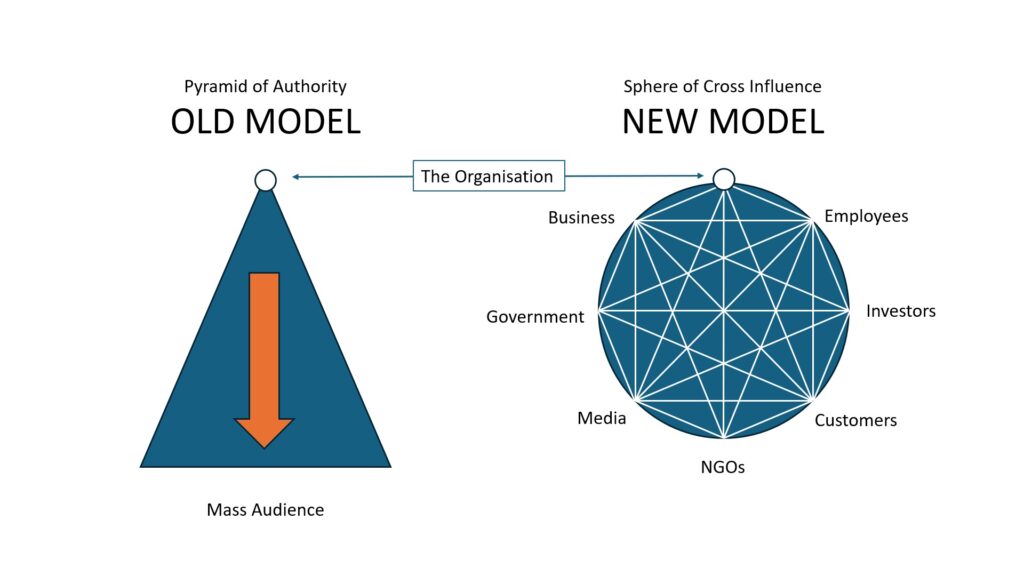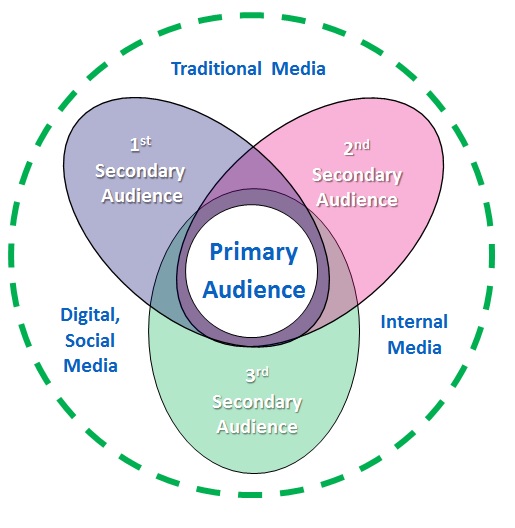One of the first steps in defining, examining and understanding all potential target audiences in advance of a strategy meeting or brainstorm is to organise them into their spheres of priority and influence.
The organisation system – known as the Target Audience Universe – was created as a by-product from the New v. Old Models of Communications.
The Old Model (known as the Pyramid of Authority) demonstrated how one large, single, often monolithic organisation spoke to its audience as a mass whole. The audiences rarely if ever questioned the integrity of the organisation or the credibility of its information or message. That model reined supreme until the internet came along to change virtually everything in its path.
In its place, the New Model called the Sphere of Influence showed how the internet created many voices, from virtually anywhere and influencing virtually anyone else. The primary speaker (the organisation, the company, the brand) was no longer the centre of attention. It no longer controlled the conversation, and was no longer above being criticised. Anyone with a keyboard and a broadband plan was as relevant as the organisation. Any message could be communicated, marginalised, diffused or rejected. Not only did the Internet make all audiences equal, it also allowed anyone to generate their own distinct level of influence.
This New Model is helpful to keep in mind when mapping the audiences in your plan. The Target Audience Universe categorises each group into their areas of importance, by:
- Putting the most important audience in the centre (the single audience who you want to change their attitude, opinion or behaviour),
- Organising the secondary influencers in an appropriate way around the centre audience, and:
- Placing the right “media” in the appropriate orbits around the audiences who consume them.
The Target Adience Universe Chart
Primary Target Audience
In the centre, the primary audience is the group which will help an organisation accomplish its business objective or achieve its business result. For example, it’s the audience which buys the organisation’s product or service. When this audience isn’t an existing customer or doesn’t share its point-of-view, marketing and communications often help change their attitude, opinion or behaviour through messages and tactical programmes.
Side note: The chart (right) is shown as a symmetrical chart but it never is. Secondary and media audiences will grow (or diminish) in size depending upon who they influence. Most important, never ever forget who the primary audience is. If they don’t change their opinion or behaviour, you may not get the business result you want.
Secondary Target Audiences or Key Opinion Leaders
These are the homogenous groups of people which have either positive or negative influence on the primary audience. They are organised by how they affect a certain outcome, whether it be a certain opinion, behaviour or decision. In a campaign of limited resources, it’s vital to focus communications on the most persuasive groups – whose spheres of influence often and can overlap, as shown. As examples, these secondary groups may be:
- Business groups the primary audience is a member
- Doctors, GPs or other medical professionals
- Business partners, joint venture partners or any other immediately relevant group which helps the organisation pursue its business goals
Media – Traditional and Digital
This group has grown the most in the past decades, and will continue to change as the internet and its technolodies, like AI, become more powerful. While traditional media may no longer be the force they were, don’t count them out for delivering key messages to key target audiences.
One thing to be aware: never put the media in the centre. Even if they change the media’s attitude or behaviour, would you actually and directly change the business outcome? If not, keep them as an influencer.
Shown in green, the outside sphere is the Media, which can be divided into three sub-groups:
External Media – for example, consumer, business, industry, trade, vertical or category media
Internal Media – for example, work-based communications, such as employee newsletters and other forms of organisational communications
Digital Media – anything from the Internet or web, including websites, social media (blogs, chat-rooms), and organisational intranets
One final point for clarification. Just because the Primary Audience is in the centre does not necessarily make it most important.
In many cases, the role of communications is more vital to building influence among the secondary audiences, or the media. But, be careful too not to place too much emphasis and resources on speaking to target audiences which don’t directly influence the business result. For example, programmes that simply generate media coverage or website hits – but not change the business result – is a waste of all resources.
How have you organised your target audiences in the past? Please feel free to comment or add your thoughts below.



No comment yet, add your voice below!